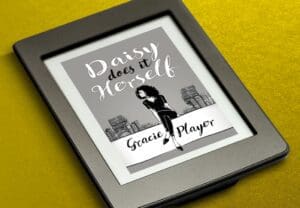
She’s selling how many!?!
“Thanks Spiffing, I’m currently selling 400 books every month!”
Bridget is a great writer, but she’s also clever. She’s realised that writing a book is simply the first step on the ladder to becoming a successful self-published author. After all, it’s not luck that sells books; there’s a formula to increasing your sales. It’s not a complicated process, and ticking off all the steps below in roughly the right order can be a very powerful tool. We hear many success stories from the authors we collaborate with, so this week we felt it would be helpful to tell you about Bridget, and to explain how she and many others like her are developing their profile as authors and creating a self-publishing success story of their own. So here is our tested approach to giving your book sales a boost. A professional book cover will increase your sales figures.
1. ‘Big publisher-style’ cover design
Big publishing houses place a great deal of emphasis on beautiful book covers because they recognise that people buy with their eyes. When a prospective buyer is browsing, your book has one brief chance to stand out, so ensuring you have a stunning cover is crucial. Ask yourself this: “Would my book cover look mediocre alongside others on the shelves of a top high-street book store?” If the answer is “yes”, then this is something that needs to be addressed before you proceed. It’s telling that Bridget submitted two identical adverts to Horse & Hound for her book, Bolted. The only difference between the two was that the second advert featured the cover we’d designed for her (see below). The first advert resulted in 149 sales while the second, featuring our cover design, achieved 392 sales, proving conclusively that a professional cover will increase your sales figures.
2. An arresting blurb
Assuming interest has been aroused in your book through its carefully designed front cover, next potential readers will judge whether your book is worth buying based on the blurb on the back cover. Those few words, and how effectively they’re written, can make a huge impact, or they can be forgotten in a moment. Make sure your blurb is concise, true, edited impeccably and, most of all, arresting! It’s astonishing how many good books Spiffing Publishing receives with bad blurbs. Get it right and you could be looking at very good sales; get it wrong and you’ll ruin your chances.
3. A professional edit
The most well-known authors will tell you that the worst person to edit their books is themselves. After spending hundreds of hours toiling over your manuscript, being able to spot discrepancies in continuity, inconsistencies in style or grammar issues is nigh on impossible. You’re simply too close to your work. So it’s sad that too many authors overlook professional editing. This is a huge mistake. If a book contains errors when published, it will inevitably receive bad reviews, and the knock-on effect will be poor sales. An editor’s job is to take your story and turn it into a perfectly written book without changing its style or tone at all.
Bridget took advantage of a free Amazon promotion and sold 115 books in just two days
4. Know where you’re selling
Bridget chose to sell her eBooks via Amazon Kindle, and her POD paperbacks via Createspace. There are more options but these are a good start. Getting to know the ins and outs of your selling platform will enhance your chances. For instance, Bridget took advantage of a free Amazon promotion and sold 115 books in just two days. As a result, her book also shot up the Amazon lists and sat between two of Bernard Cornwell’s Sharpe books, lending her a certain prestige via association. She also signed up for the Amazon Kindle Prime customers’ lending-library scheme, because there’s a good chance that a borrower of one of your books could become a buyer of another. There’s a host of selling opportunities out there and if you spend time looking into the latest deals and promotions, your visibility and sales can really benefit.
5. Online presence
If we design a cover for you, then something that’s included in the service is a free online presence. Our ‘Nanosites’ are effectively dynamic little websites that perform as incredibly powerful tools, driving traffic to your selling platforms. Our authors love their simplicity and, when shared on their social media pages and mailing lists, they can reach a new readership and make a professional impression.
6. Get your pricing right
Take time to consider the price of your book. Forget about what you’d like to make, per sale, for the moment. Consider what you’d pay an independent author who has one or two books published, and then consider how much you’d pay for a book written by your favourite, established author. You’ll probably come up with two different figures. The most important thing is to get your titles moving, and not to let them stagnate. Start with a realistic price and see how it goes. In Bridget’s case, she’s settled on approximately £3 per eBook. Her approach is steady, knowing that one day she’ll be able to charge more as she becomes better known and her profile as an author inspires confidence in her readership.
7. And finally … write more books!
Simply put, if you write more books then you’ll sell more books! We’re not just talking about multiplication – i.e. if you write two books, your sales will double; we’re saying that sales can grow exponentially. The reason for this is that we all invest time in those things that give us a high return for our invested interest. This is why ‘box-set’ TVshows are selling so well. The same applies to readers who choose certain authors. If they see that you’re an established writer with multiple books, which are professionally designed and have good reviews, then they’re far more likely to buy your books again and again… plus they’re likely to tell their friends about you too. We’ll let Bridget have the final word…
“It’s like a snowball effect, the more books I write, the more books I sell; the higher my sales figures, the more people are interested in buying my book.”
Bridget Beresford

















